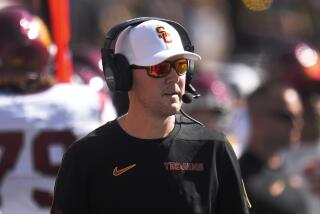Danny Gardella, 85; Sought Labor Rights
Danny Gardella, a former major league baseball player best known for his early effort to overturn the game’s reserve clause, has died. He was 85.
Gardella died of congestive heart failure March 6 at a hospice in Yonkers, N.Y.
Gardella’s 1947 lawsuit was the first significant challenge to baseball’s exemption from federal antitrust law and foreshadowed later attempts to change labor relations in baseball.
An outfielder of limited defensive talent -- he was said to fear fly balls -- Gardella was signed at a time when many of baseball’s stars were serving in the military during World War II. He played just two seasons for what was then the New York Giants. His best year for the Giants was 1945, when he batted .272 with 18 home runs and 71 runs batted in.
But going into the 1946 season, baseball’s rosters were getting back to normal as top name players were returning from military duty, and Gardella faced the prospect of limited playing or assignment to the minors.
A more lucrative option was the Mexican League, which began luring stars such as Giant pitcher Sal Maglie and Dodger catcher Mickey Owen by offering double and triple the salaries paid by U.S. owners. Gardella doubled his $5,000 annual salary with the Giants by signing with the Vera Cruz club.
That prompted baseball Commissioner A.B. “Happy” Chandler to decree in June 1946 that any player jumping to the Mexican League would be barred from returning to the major leagues for five years. He cited the reserve clause in the standard player contract, which bound a player to a team for life unless the team traded him to another club or released him. At the time, players were compelled to accept any contract the team offered, and there was little room for negotiation on salary.
Chandler’s ultimatum meant little to the free-spirited Gardella. After one season in Mexico, he played one in Cuba, where he led that league in home runs.
When he returned to the United States, he was unable to find work in professional baseball, so he went back to semipro ball.
Baseball, however, didn’t leave him alone.
In 1947, Gardella was scheduled to play against a barnstorming squad of Negro League stars in an exhibition game on Staten Island in New York.
As Gardella recalled in an interview with a Times reporter some years ago, the baseball commissioner’s office sent a telegram to the stadium during the game. Read over the public address system, the telegram stated that any player caught participating in a game with Gardella or any of the other major leaguers who had played in the Mexican League would be banned from the major leagues for life.
Gardella knew the stakes were high for the black ballplayers. That spring, Jackie Robinson broke the color barrier in baseball when he was signed by the Brooklyn Dodgers. Other signings of black players were expected. So Gardella pulled out of the game.
But he didn’t go quietly. Feeling insulted at what he felt was an unnecessary public humiliation, he filed a $300,000 lawsuit against Chandler, the Giants and the American and National leagues, charging them with conspiracy to restrain free trade. Gardella noted that the reserve clause was being used by baseball to deprive him of his right to make a living.
In July 1948, Gardella’s suit was rejected by a district judge who cited the 1922 U.S. Supreme Court decision that baseball was not subject to laws governing interstate commerce. But Gardella won a victory in February 1949 when a federal appeals court ruled that the suit must be heard and ordered a jury trial.
The baseball establishment, fearing a negative outcome in the trial, turned up the heat. Dodger executive Branch Rickey testified before a congressional committee that Gardella and others who opposed efforts to strengthen baseball’s antitrust exemption “lean to communism.” Rickey also said that “without the reserve clause, baseball cannot endure.”
In his view, the business of baseball would not have been able to support a system where players could sell their services to the highest bidder.
Baseball officials subsequently offered amnesty to any player who had jumped to the Mexican League. The amnesty allowed Owen and Maglie, among others, to return to the major league teams that held their lifetime contracts.
Gardella pressed ahead with his lawsuit. But facing the prospect of huge legal bills and delays, he dropped the action after getting a promise from Major League Baseball that he could play for the St. Louis Cardinals in the spring of 1950. He later said he got a cash settlement of $60,000.
His time with the Cardinals was fleeting. It consisted of one at-bat before he was sent to the minor leagues.
A native of New York City, Gardella grew up in the Bronx and started his professional baseball career at the age of 17. He played in the minor leagues in Florida and later Arkansas before giving it up for a job in the New York shipyards.
After his one-game season with the Cardinals, Gardella returned to the New York area, where he worked in a variety of blue-collar jobs over the next several decades.
Efforts to overturn the reserve clause came up again in the early 1970s. In perhaps the most notable court challenge, Curt Flood, an outfielder for the Cardinals, took up the cause when he didn’t want to be traded to the Philadelphia Phillies. He took his case to the U.S. Supreme Court but lost in 1972.
Three years later, an arbitrator ruled that pitchers Dave McNally and Andy Messersmith could negotiate with other clubs after their contracts expired.
In 1976, the players reached a broad agreement with the owners that stated a player with six years’ major league experience who was not under contract was free to seek an agreement with any team he wanted.
For his part, Gardella voiced pride in his role in baseball’s labor history.
“I feel I let the whole world know that the reserve clause was unfair,” Gardella told a Times reporter in 1994. “It had the odor of peonage, even slavery.”
Gardella is survived by 10 children and 27 grandchildren.
More to Read
Go beyond the scoreboard
Get the latest on L.A.'s teams in the daily Sports Report newsletter.
You may occasionally receive promotional content from the Los Angeles Times.










